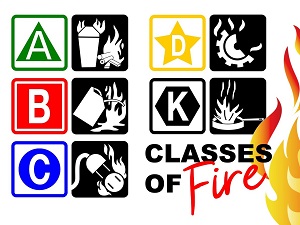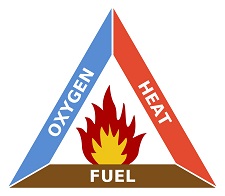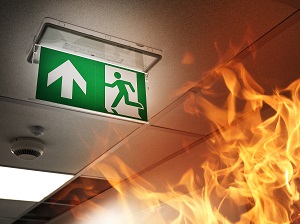When learning about fire protection and prevention on the job, it is important to understand the different types of fire that may have the opportunity to occur at any specific work location. The type of fire will determine the fire extinguishing method required.

There are 5 major classifications of fire, known as A, B, C, D and K. Depending on which class of fire ignites will determine how trained personnel act to extinguish the fire because different types of fire extinguishers are designed to fight different classes of fire.
The Fire Triangle: Fuel, Heat, and Oxygen
Fire requires three elements which are fuel, heat and oxygen, known as the fire triangle, and in the right combination the resulting chemical reaction can cause a fire. The key to extinguishing a fire is to remove at least one of the elements from the fire.
Common Ignition and Fuel Sources
Ignition sources can include any material, component, equipment or operation that produces a spark, a flame or radiates heat including welding torches, static electricity, grinding tools, catalytic converters and mufflers.
Fuel sources that can start a fire include combustible materials such as wood, paper, trash or clothing, flammable liquids like gasoline, and flammable gases like propane.
Oxygen, the third element required to create fire, comes from the air in the atmosphere.
OSHA Standard 1926.150(a)(1) The employer shall be responsible for the development of a fire protection program to be followed throughout all phases of the construction and demolition work, and he shall provide for the firefighting equipment…

Class A Fires: Ordinary Combustibles
Class A fires involve ordinary combustible materials like cloth, wood, paper, rubber, many plastics and most kinds of trash.
Water is one of the most commonly used extinguishing agents for Class A fires.
Air-Pressurized Water Extinguishers (APW) can be used on a Class A fire. APWs are large silver canisters that are only used on Class A fires.
Multi-Purpose Dry Chemical Extinguishers, rated ABC, may also be used to put out a Class A fire. ABC multi-purpose extinguishers are red and range in size from five to 20 pounds. Multi-purpose fire extinguishers are common and can be found in a variety of industrial settings. Some dry chemical extinguishers are only rated for B and C class fires so it is important to recognize if the multi-purpose fire extinguishers are labeled for ABC use, if needed.
Carbon Dioxide fire extinguishers are not recommended for Class A fires because the fires may continue to smolder and can re-ignite after the carbon dioxide dissipates.
OSHA Standard 1910.157(d)(1) Portable fire extinguishers shall be provided for employee use and selected and distributed based on the classes of anticipated workplace fires and on the size and degree of hazard which would affect their use.

Class B Fires: Flammable Liquids and Gases
Class B fires involve flammable and combustible liquids such as gasoline, alcohols, oil-based paints, petroleum greases, tars, oils, and solvents. Class B fires can also be started with flammable gases like propane and butane. Class B fires do not include fires involving cooking oils and grease.
Carbon Dioxide fire extinguishers or multi-purpose dry chemical fire extinguishers, rated BC or ABC, can be used to put out a Class B fire. Do not use carbon dioxide extinguishers in a confined space if personnel in the area are not wearing the proper respiratory protection.
Do not attempt to extinguish a fire involving flammable gas unless the source of fuel can be located and turned off safely. Extinguishing a flammable gas fire without first shutting off the source may result in an explosion if the unburned gas is released into the air and then exposed to an ignition source. If the only fuel burning is leaking gas, the best method for extinguishing the fire is to shut off the fuel supply.
Never use water to extinguish a flammable liquid or gas fire. Water is extremely ineffective at extinguishing Class B fires and may make the situation worse by spreading the fire.

Class C Fires: Energized Electrical Equipment
Class C fires involve energized electrical equipment such as computers, servers, motors, transformers, wiring, fuse boxes, and appliances. There is a potential for Class C fires in any place where electrical wiring is present or electrical equipment is in use. A Class C fire can ignite when there is faulty wiring, overcharged devices, overloaded outlets, electrical cord damage or a short circuit. If you remove the power to the energized electrical equipment that has caught on fire, then a Class C fire becomes one of the other classes of fire.
Carbon Dioxide fire extinguishers or multi-purpose dry chemical fire extinguishers, rated BC or ABC, can be used to put out a Class C fire.
Do not attempt to use water to extinguish an energized electrical fire. Water is a good conductor and attempting to use water to extinguish an electrical fire may lead to electrocution. Electrical equipment must be unplugged and/or de-energized before water can safely be used to attempt to put out flames that started as an electrical fire.

Class D Fires: Combustible Metals
Class D fires involve powders, flakes, dust, machine shavings or other fine pieces of combustible metals like lithium, magnesium, potassium, sodium, titanium, or zirconium. Metal fires can ignite by the same sources that start other common fires.
The most common method for extinguishing a combustible metal fire is to cover the burning material with a dry powder extinguishing agent that works by smothering the fire, separating it from oxygen and absorbing the heat. Different metals may require different extinguishing agents.
Dry powder fire extinguishers (rated D) should not be confused with dry chemical fire extinguishers. Using a dry chemical extinguisher on a Class D fire can increase the intensity of the fire or be ineffective.
Class K Fires: Cooking Oils and Grease
Class K fires involve vegetable oils, animal fats and grease in cooking appliances.
Fire extinguishers with a K rating may be required in commercial kitchens where large quantities of food are prepared using oil or grease.
Do not use a Class A fire extinguisher that contains water or a carbon dioxide fire extinguisher on a deep fat fryer because an explosive reaction may occur.

.jpg)

